Harrison Park (July 19)
We got off to a very early start, and reached the border by 10 a.m. (Often we have not even hitched up by then.) We were greeted by a customs agent with a classic Canadian accent punctuated by an “eh” at the end of every sentence. I felt welcomed home – especially as the entrance interview was primarily the agent expressing enthusiasm at learning we were heading up to Georgian Bay for a vacation.
Since we were making good time, we decided we could make it all the way to Owen Sound, a 5 hour drive from Barcelona.
My mother’s favorite aunt, Aunt Ida, owned a women’s clothing shop in Owen Sound. Because of this, in my childhood, we went there frequently to visit (and for my mother to shop for clothes). As well, the route passes through the green belt around Toronto that was the destination of many family and friends picnic, beach, hiking and tobogganing trips. As a result, most of the route was a nostalgia trip for me as we passed so many parks and towns whose names I knew well (although after 45 years, I doubt I would recall what these places look like, even without the changes time has brought).
Once we left Hwy 407, most of the trip was on Hwy 10, a very secondary road, which was mostly one lane in each direction. However, we were always behind vehicles moving more slowly than we would have, which I think eased Chuck’s usual worry that we hold up traffic. In any case, I won’t say the drive was easy (Chuck was doing the work) but it was not unduly stressful.
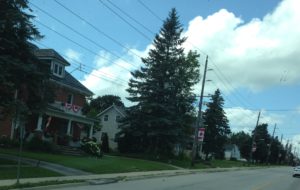 In my childhood, we used to make fun of the way that Americans put flags everywhere. No more. Perhaps it was due to the 150 year anniversary of Canada, but there were flags everywhere – on fence posts, front doors, pick-up trucks, and most notably, taking the place of the traditional hanging baskets of flowers on the main street lampposts of most of the small towns we passed through. A single small town yielded more Canadian flags than I used to see in a year – and that includes 1967, Canada’s centennial and the year that the maple leaf flag was adopted.
In my childhood, we used to make fun of the way that Americans put flags everywhere. No more. Perhaps it was due to the 150 year anniversary of Canada, but there were flags everywhere – on fence posts, front doors, pick-up trucks, and most notably, taking the place of the traditional hanging baskets of flowers on the main street lampposts of most of the small towns we passed through. A single small town yielded more Canadian flags than I used to see in a year – and that includes 1967, Canada’s centennial and the year that the maple leaf flag was adopted.
Most of the route is through farm country – primarily corn and rapeseed (Canola). The latter looks like (and is related to) wild mustard and is used for cooking oil, animal feed, biofuel, and lubricants. Another local farm product is power – there are many wind farms just off the highway.
Owen Sound has two attractions for us: My cousin Stephen and his wife Elaine, with whom we are close, still live there. And it is at the base of the Bruce Peninsula, one of the beautiful hiking and wilderness spots in the Northeast. N
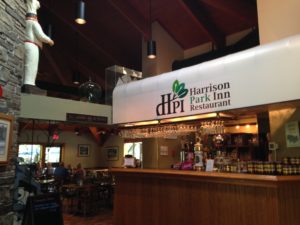 Owen Sound has a lovely civic park, Harrison Park, that has RV sites. We pulled in beside the Sydenham River, and near Weaver Creek, both of which flow through the park.
Owen Sound has a lovely civic park, Harrison Park, that has RV sites. We pulled in beside the Sydenham River, and near Weaver Creek, both of which flow through the park. 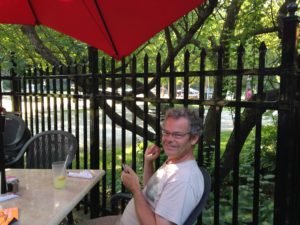 Among its many amenities, the park has a nice restaurant (which we visited for supper), a small bird sanctuary, a historical park celebrating Owen Sound’s historical significance as a final destination on the Underground Railroad, links to the Bruce Trail (which runs 890 km from Tobermory to Niagara Falls along the Niagara Escarpment, with 400 km of side trails) and a swimming pool.
Among its many amenities, the park has a nice restaurant (which we visited for supper), a small bird sanctuary, a historical park celebrating Owen Sound’s historical significance as a final destination on the Underground Railroad, links to the Bruce Trail (which runs 890 km from Tobermory to Niagara Falls along the Niagara Escarpment, with 400 km of side trails) and a swimming pool.
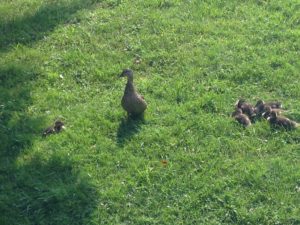
This large duck family was enjoying the bird sanctuary.
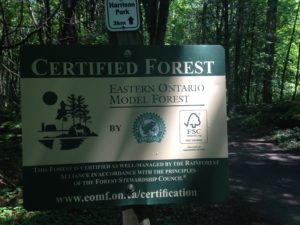 We thought it was obvious that we were in a forest and were surprised that certification would be needed to verify the fact. Actually the certification is for the management program for the forested lands.
We thought it was obvious that we were in a forest and were surprised that certification would be needed to verify the fact. Actually the certification is for the management program for the forested lands.
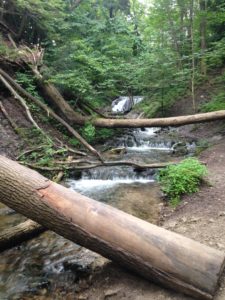
Walter’s Falls, a few yards (or meters) from the park at the top of Weaver Creek.
With our “just on time” scheduling, we were lucky that my cousins were in town and available to visit with us. After we set up and had dinner, I went with them to a “big band” concert at the Marine Rails Museum, while Chuck relaxed at home.
My childhood visits to Owen Sound were typical family visits. We spent most of our time at my aunt’s house (still standing, but now at the edge of a strip mall) and store. We occasionally went to Harrison Park for a walk. We sometimes went canoeing on the Sauble River, nearby, and we usually visited Inglis Falls, the largest waterfall in the area. As a result of this rather limited itinerary, I was not aware that Owen Sound is actually on a sound on Georgian Bay, close to many beautiful sand beaches and with great historical significance. (In fact, the link with the Underground Railroad was a shock to me.) Owen Sound is not a typical tourist destination, but I think we could happily spend a couple of weeks here without exhausting its tourism possibilities. This blog entry is rather long, due to the many things we enjoyed during our visit.
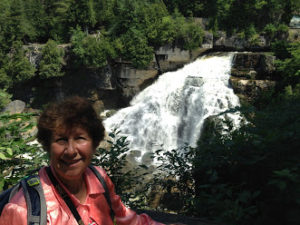 On Thursday, after a torrential thunderstorm, we met Stephen in town for coffee and then went back to Harrison Park to hike. We took a branch path of the Bruce Trail to Inglis Falls, which was spectacular after the rain. It was a lovely walk through the woods and through Inglis Arboreteum – although a bit buggy in the damp weather.
On Thursday, after a torrential thunderstorm, we met Stephen in town for coffee and then went back to Harrison Park to hike. We took a branch path of the Bruce Trail to Inglis Falls, which was spectacular after the rain. It was a lovely walk through the woods and through Inglis Arboreteum – although a bit buggy in the damp weather.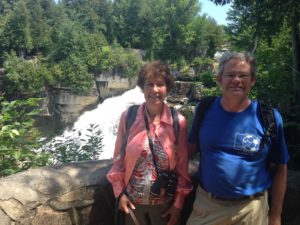
In the late afternoon, Stephen and Elaine picked us up and took us to the Owen Sound synagogue. I did not take any pictures, but they have a great website (https://bethezekielcanada.wordpress.com). This is the last small town synagogue in Canada, and has survived a reduction to 20 families at its low point. It now has 60 families, and appears to be quite vibrant. (I was aware that there was a small congregation in Owen Sound that met for services led by a member, but I did not know there was an actual synagogue.) The congregation was established in 1904, and the current building was purchased (from a church) in 1947. In 2001, a project was started to install stained glass windows celebrating some of the life stories of congregation members – these beautiful windows line the sanctuary and each is labelled with the inspiration for the design. ( These can be seen in here: https://bethezekielcanada.wordpress.com/artwork/our-windows/) In 2005, the synagogue courtyard was transformed into the Heritage Garden, a welcoming sitting space. In 2006, a section of the town cemetery was set aside for the congregation – prior to this, the dead were transported to the same cemetery in Toronto where my parents were buried. And in 2007, with the establishment of the Grey Roots Museum to document life in Grey County, the synagogue compiled a history of the Jewish community in Owen Sound, including an impressive book, a separate book just about the windows and (of course) a cookbook – all of which were gifted to us by the synagogue treasurer. This historical document is an impressive piece of work, and makes me think that a similar project for State College Jewish community would be worthwhile.
Following our synagogue tour, my cousins took us Port Elgin for dinner. This town, with a long beach on Lake Huron, is clearly thriving on tourism. It has a cute downtown with many restaurants. There is a town dock (of course) and on this day there was a car “cruise” featuring many old and fancy cars.
After dinner, we continued on to the marina to look at Lake Huron (which is high this year) and the boats. There is a bicycle and walking path that goes for miles along the lakeshore (and past the mansions there).
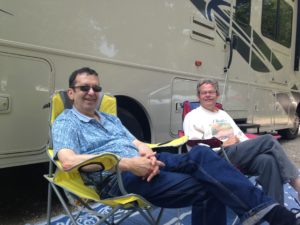 In the morning, Stephen showed up by bicycle for a quick visit. After he left, we considered whether to launch the kayaks.
In the morning, Stephen showed up by bicycle for a quick visit. After he left, we considered whether to launch the kayaks.
 With our campsite right beside the Sydenham River, it was hard to resist trying out our (fortunately indestructible) kayaks on the small rapids that run the length of the campground. In fact, a lot of kids were going down on inner tubes or inflatable rafts. We both bounced off several boulders, as the water was quite shallow and very fast. However, these kayaks really are indestructible and no harm was down.
With our campsite right beside the Sydenham River, it was hard to resist trying out our (fortunately indestructible) kayaks on the small rapids that run the length of the campground. In fact, a lot of kids were going down on inner tubes or inflatable rafts. We both bounced off several boulders, as the water was quite shallow and very fast. However, these kayaks really are indestructible and no harm was down.
At the downstream side of the park, the river opens up and is much calmer, with almost no current. There are a lot of big homes with beautiful gardens. There are also a huge number of Canada Geese and mallard ducks, and a few more interesting birds such as a green heron and many belted kingfishers. We were able to navigate the river down to a dam created for a grist mill, passing under a bridge that is practically downtown, and then return to the park. While it was not too much of a portage back to the campsite, we were lazy and loaded up the kayaks on our car.
We then headed into town to the Tom Thompson art gallery. Tom Thompson is one of my favorite Canadian painters. He spent a lot of time in Algonquin Park and other places where I used to camp. Most of his major works are in collections in Toronto, including the McMichael, which we visited earlier. The museum has many of his sketches and small studies, as well as work from local artists. One local work captured my interest because it echoed my experience. It shows a tourist looking at a bleak Algonquin vista and seeing the vibrant colors of a famous Thompson painting. Thompson’s paintings resonate with me partly because I have been there and seen what he saw, and partly because I see more because of his paintings (and the Group of Seven).
Another feature of the gallery is a set of plaques detailing some of the sad history of the First Peoples and their negotiations with the British government. As we all know, they kept being promised the use of their traditional lands in perpetuity – and then being forced off. Note that in Canada, Native Americans are referred to as First Peoples (since we use “native Canadian” to mean anyone born to Canadian parents).
One installation at the gallery we did not enjoy starts right at the entrance. You are invited to watch a short film about a diary that was discovered documenting Thompson’s friendship with a local man. It is intriguing because Thompson, an accomplished outdoorsman and canoeist, drowned on a solo trip to Algonquin and this diary seems to offer clues to his death. However, upon exiting the main exhibit, you learn that this diary is a work of fiction, and you are invited to view historical artifacts doctored to fit the fictional character’s life. I can see that this counts as art, but neither Chuck nor I enjoyed the misdirection.
After the art gallery, we walked downtown and conveniently (and accidentally) ran into Stephen. We then picked up Elaine and went out for Chinese food.
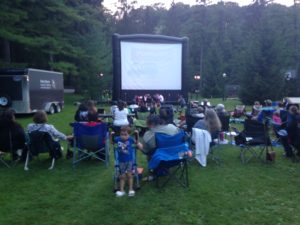 In the evening, the park had a First Nations event, featuring a drumming group and a film documentary about the first First Nations’ spelling bee team from Alberta. I cannot imagine the culture shock of the 3 children who won and participated in the national bee in Toronto. One of them made it into the final round – quite an amazing showing.
In the evening, the park had a First Nations event, featuring a drumming group and a film documentary about the first First Nations’ spelling bee team from Alberta. I cannot imagine the culture shock of the 3 children who won and participated in the national bee in Toronto. One of them made it into the final round – quite an amazing showing.
We decided to stay in Owen Sound for an additional day, but we unfortunately had to change campsites, which always takes a couple of hours. The good thing about it is that we ended up chatting with several of our neighbors. By the time we were set up and talked out, it was mid-afternoon. However, I really wanted to see the local history museum, Grey Roots, so off we went
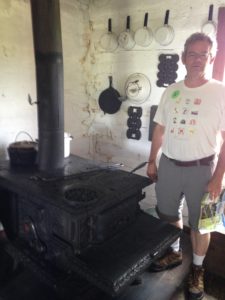 This is a history museum documenting primarily post-native settlement in the county, including a “village” made of up reconstructed buildings from the area – a small settler log cabin, a larger log cabin, a 1920’s house, and several other buildings including a barn, sawmill, garage (with old cars and trucks) and blacksmith shop. This iron stove was made in Brantford, the town where I was born.
This is a history museum documenting primarily post-native settlement in the county, including a “village” made of up reconstructed buildings from the area – a small settler log cabin, a larger log cabin, a 1920’s house, and several other buildings including a barn, sawmill, garage (with old cars and trucks) and blacksmith shop. This iron stove was made in Brantford, the town where I was born.
The most fun part of the village was the garage, due to the docent – a former mechanic somewhat older than us. 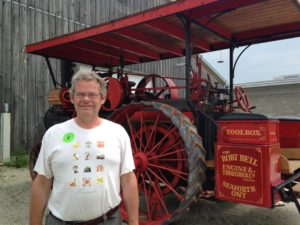 He was very knowledgeable about the older vehicles on display, and had worked on some of the newer ones. Many of the buildings had knowledgeable docents suitably dressed in period clothing, but it was special to learn from someone who had actually experienced at least some of the life he was explaining.
He was very knowledgeable about the older vehicles on display, and had worked on some of the newer ones. Many of the buildings had knowledgeable docents suitably dressed in period clothing, but it was special to learn from someone who had actually experienced at least some of the life he was explaining.
The opening exhibit in the main building was about Owen Sound’s less savory days as Canada’s “Sin City”. One intersection was known as “Damnation Square” for the pubs on each corner, while another was known as “Salvation Square” for its 4 churches. In 1905 the ” Women’s Christian Temperance Union” successfully lobbied for prohibition in the town. Amazingly, it was passed, and Owen Sound remained dry until 1972. Needless to say, this did nothing for the breweries and restaurants in town, but it did move the drinking to more discreet locations. (Maybe this is why Owen Sound is not a big tourist destination despite its many attractions.)
Another exhibit in the museum documents Owen Sound’s black community. Although the first blacks arrived as slaves, they were emancipated by the abolition of slavery in the British Empire in 1833. Meanwhile, back in the US, the Fugitive Slave Act of 1850 meant that fleeing slaves, and even free blacks, were at risk of being returned to slavery from so-called “free” states in the US. As a result, the “Underground Railway” extended into Canada, and Owen Sound was a terminus. Because of this, Owen Sound had a substantial African American population. This is not to say that there was no discrimination in Owen Sound, but many black citizens did rise to prominence. There is an annual Emancipation Festival that has been held since 1862 in Harrison Park.
Other exhibits in the museum documented various aspects of European settlement in the area. Oddly, settlement did not really begin until the 1830s, due to the heavily forested terrain and lack of roads. However, once a road was put in from Toronto, there were influxes of Irish and Scots, fleeing the potato famine, as well as Germans. These immigrants farmed as started small industries, such as grist and wood mills, breweries, etc some of which grew into large companies. However, in the past 20 years, many more companies have closed than have started in the area.
This is a small but very interesting museum.
We had a quiet dinner at Harrison park, eating our left-overs from Port Elgin and resting up before our next travel day.
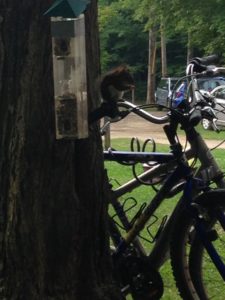 Our last day in Owen Sound, a red squirrel found our bird feeder. For some reason, only one bird, a blue jay, visited our feeding during our entire stay. Normally, having a squirrel raid the feeder would not thrill me. However, under the circumstances, watching this cute little guy enjoying breakfast at our expense was a real pleasure.
Our last day in Owen Sound, a red squirrel found our bird feeder. For some reason, only one bird, a blue jay, visited our feeding during our entire stay. Normally, having a squirrel raid the feeder would not thrill me. However, under the circumstances, watching this cute little guy enjoying breakfast at our expense was a real pleasure.
The last day in any place is our travel day. Usually on a travel day we do nothing but pack, travel and unpack. However, with only 1.5 hours to our next destination, we decided we could do a couple of things before we left. After a quick trip to the grocery store, we headed to the Marine Rail Museum.
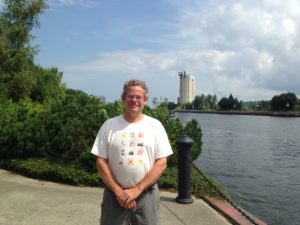 This little gem is in the old train station on Owen Sound (the bay) across the sound from the big grain elevator. It has a riverwalk with interpretive signs, and a small exhibit space in the station.
This little gem is in the old train station on Owen Sound (the bay) across the sound from the big grain elevator. It has a riverwalk with interpretive signs, and a small exhibit space in the station.
Owen Sound was once a major industrial and shipping center. With abundant water power and wood, the first settlers established grist and lumber mills, breweries, furniture factories and more. With access to the Great Lakes, it was a natural shipping center, particularly once a rail line was built to Toronto. For this reason, the Canadian Pacific Railway built a major grain elevator there, and extended the rail line for shipping grain. The harbor used to be among the busiest on the Great Lakes. (Hence there was plenty of traffic to take advantage of Damnation Square.) It was also a natural location for ship building. Another major industry was a foundry, which built large pieces of ship hardware, including propellers. With all this lumber at hand, Owen Sound was also home to a large company that made wooden toothpicks, which were exported around the world. (You would think that toothpicks would be a local industry.)
Many of these factories suffered multiple fires, but were rebuilt. Rebuilding after a disaster provides opportunities to modernize – particularly if insurance pays some of the costs. (Interesting factoid: In 2015 I visited one of the few iron factories in Germany that survived WWII. However, it did not survive the post-war recovery. The rebuilt factories were able to install modern manufacturing equipment, and once they were established they could outcompete this huge factory even with the large cost of reconstruction.)
Most of these industries are now defunct. After a fire at the grain elevators, CPR moved the grain terminus to another city on the lake (although a new elevator was built and dominates the skyline.)
The largest local industry is now health care, although there is Georgian College, which has a well-regarded marine engineering program. Oddly, one of the industries that remains is a printer, which produces, among other items, government forms. I say oddly, because one of the industries that has almost folded due to computing, is printing.
In any case, this little museum was definitely worth the visit.
These days, downtown Owen Sound is definitely suffering, with many closed store fronts. My aunt owned a ladieswear shop downtown, and even when I was a child she complained about competition from the “big box” stores establishing themselves on the edge of town. Of course, now there are even bigger “big box” stores, and the internet competition. Add to that the “greying” of the town, due to smaller families and younger people moving away, Store owners are retiring and not being bought out. However, as housing in southern Ontario has become ridiculously expensive, not just in Toronto but also in many of the small satellite towns, the town seems to be repopulating with retirees. It certainly has a lot to offer: close to beautiful beaches, many rivers, museums, hiking and proximity to the Bruce Trail. In fact, I would have to say that Owen Sound is a “hidden gem.” Much as I would like to see it stay hidden, it needs more tourist traffic and settlement to revitalize or be lost.
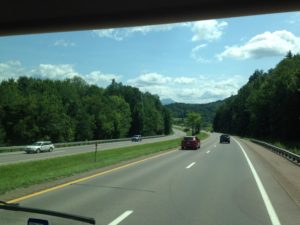 The trip was uneventful but long. We were struck by how aptly Vermont is named. At this time of year, it is all green, green mountains in every direction.
The trip was uneventful but long. We were struck by how aptly Vermont is named. At this time of year, it is all green, green mountains in every direction.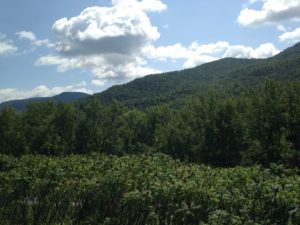 We pulled in around 4 p.m. and set up in Lone Pines RV Park, close to Lake Champlain. There are a lot of bicycle trails in and around Burlington, including one that is right across the road from the RV park.
We pulled in around 4 p.m. and set up in Lone Pines RV Park, close to Lake Champlain. There are a lot of bicycle trails in and around Burlington, including one that is right across the road from the RV park.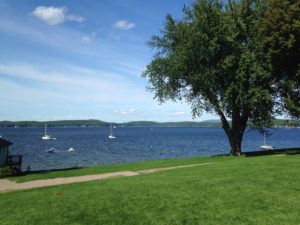 but did take me to the lake. My work was beginning to pile up, so I also spent some time on data analysis for an urgent project.
but did take me to the lake. My work was beginning to pile up, so I also spent some time on data analysis for an urgent project.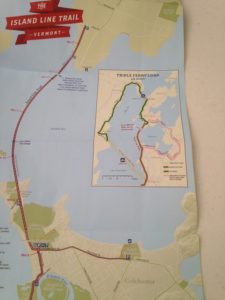 On Thursday we were both ready for a long bicycle ride. The Island Line Trail starts a few miles from the campground, goes along the Colchester and Burlington waterfront and then takes the Colchester Causeway 3 miles across Lake Champlain to South Hero on Grand Island, the southernmost of a chain of islands that stretch up the lake to the Alburgh Peninsula. This is a rail trail that goes over huge marble blocks from the quarries in Vermont (discard, I presume).
On Thursday we were both ready for a long bicycle ride. The Island Line Trail starts a few miles from the campground, goes along the Colchester and Burlington waterfront and then takes the Colchester Causeway 3 miles across Lake Champlain to South Hero on Grand Island, the southernmost of a chain of islands that stretch up the lake to the Alburgh Peninsula. This is a rail trail that goes over huge marble blocks from the quarries in Vermont (discard, I presume).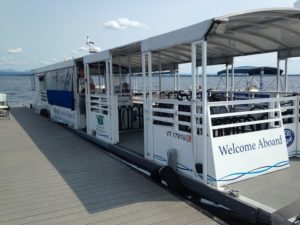 A swing bridge on
A swing bridge on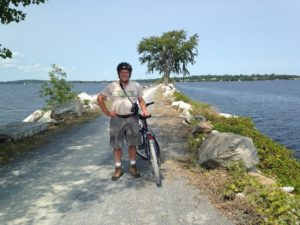
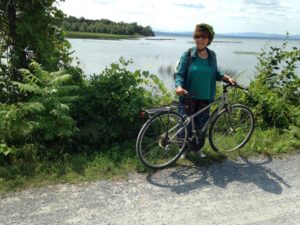
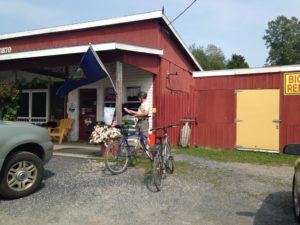 Once on South Hero, you can actually do a loop – if you are willing to take the on-road bike path and use the bridge on Hwy 2. We found even the regular roads on the island to be a bit bicycle unfriendly, though, especially as the main bicycle route, which has a wide bike lane, was being repaired. We wended our way through relatively quiet and very hilly side roads to detour around the construction, returning to the main route to get a dish of maple ice cream at a snack bar. (Maple flavored soft-serve ice cream seems to be a Vermont thing.)
Once on South Hero, you can actually do a loop – if you are willing to take the on-road bike path and use the bridge on Hwy 2. We found even the regular roads on the island to be a bit bicycle unfriendly, though, especially as the main bicycle route, which has a wide bike lane, was being repaired. We wended our way through relatively quiet and very hilly side roads to detour around the construction, returning to the main route to get a dish of maple ice cream at a snack bar. (Maple flavored soft-serve ice cream seems to be a Vermont thing.)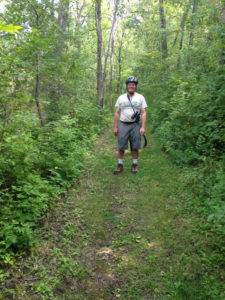 We noticed on the bike trail maps that there is a hiking and biking trail through the John Roy Wildlife Management Area – off-road and parallel to the main street – so we decided to return on it. It turned out to be as rough as the mountain bike trail we followed in Gravenhurst – flat but lots of big roots and also possibly logs that had been put down to keep hikers out of the bog. Lots of mosquitoes, too – we felt that we did our bit for the food chain. However, it was pretty, and when we got back to the road we were past the construction.
We noticed on the bike trail maps that there is a hiking and biking trail through the John Roy Wildlife Management Area – off-road and parallel to the main street – so we decided to return on it. It turned out to be as rough as the mountain bike trail we followed in Gravenhurst – flat but lots of big roots and also possibly logs that had been put down to keep hikers out of the bog. Lots of mosquitoes, too – we felt that we did our bit for the food chain. However, it was pretty, and when we got back to the road we were past the construction.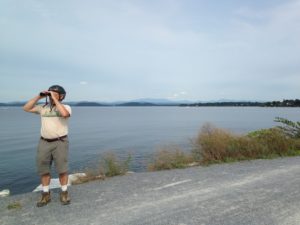 Returning on the Causeway, we saw a number of wild minks running across the trail and along the marble blocks. No photos of the minks as they are too fast and too small – just us viewing them.
Returning on the Causeway, we saw a number of wild minks running across the trail and along the marble blocks. No photos of the minks as they are too fast and too small – just us viewing them.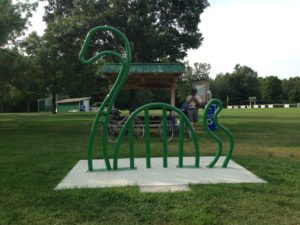 There are lots of bicyclists in Vermont, and no shortage of bicycle parking. Some of the bicycle stands are very imaginative, like this dinosaur stand near a playground on the Island Line Trail.
There are lots of bicyclists in Vermont, and no shortage of bicycle parking. Some of the bicycle stands are very imaginative, like this dinosaur stand near a playground on the Island Line Trail.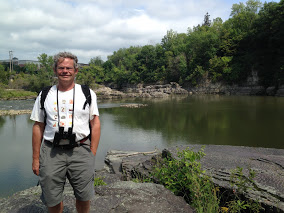
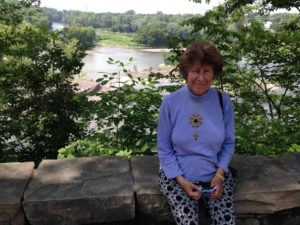
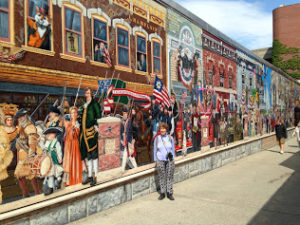
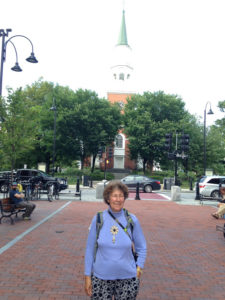
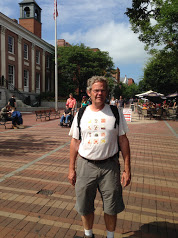
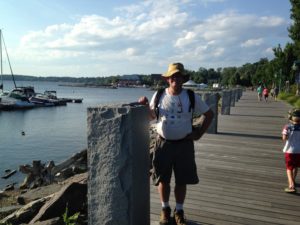 This would also have put us on the upper deck for the cruise. However, we did have a very good dinner buffet on the lower deck, where we stayed warm behind the large windows. The main dish was lobster, which Chuck does not like and I feel so-so about. However, they also had beef, which Chuck ate. I figured that since I had paid for lobster, and was headed to the east coast where I would feel obliged to eat lobster at least once, I might as well have lobster for dinner. It was nicely cooked, and in the end I had a second helping (i.e. a second lobster).
This would also have put us on the upper deck for the cruise. However, we did have a very good dinner buffet on the lower deck, where we stayed warm behind the large windows. The main dish was lobster, which Chuck does not like and I feel so-so about. However, they also had beef, which Chuck ate. I figured that since I had paid for lobster, and was headed to the east coast where I would feel obliged to eat lobster at least once, I might as well have lobster for dinner. It was nicely cooked, and in the end I had a second helping (i.e. a second lobster).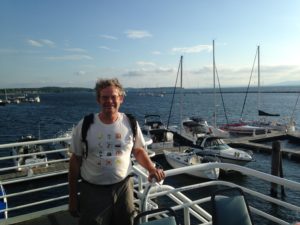
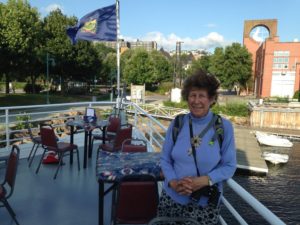
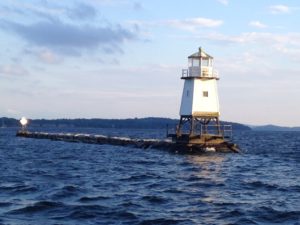
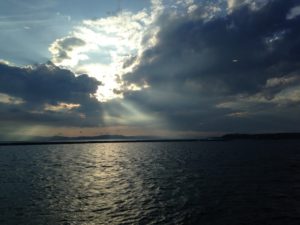
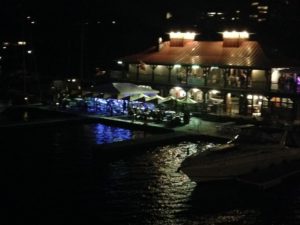 Dinner took up only about an hour of the 3 hour cruise, so we had plenty of deck time. All in all it was a lovely evening. The dockside restaurant was rightly lit up making a pretty sight as we docked.
Dinner took up only about an hour of the 3 hour cruise, so we had plenty of deck time. All in all it was a lovely evening. The dockside restaurant was rightly lit up making a pretty sight as we docked.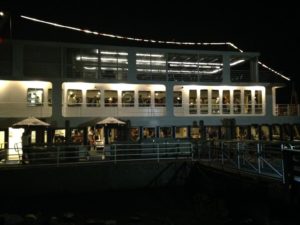
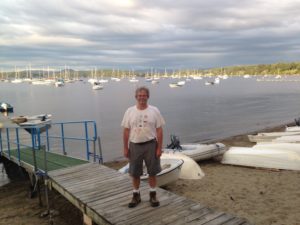
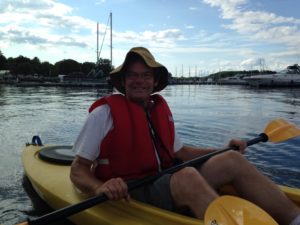 Being right next to Lake Champlain, we of course needed to get the kayaks out on the lake. Fortunately, the campground was next to Malletts Bay, a large and somewhat protected cove. On Saturday we went for a long paddle and enjoyed the lake.
Being right next to Lake Champlain, we of course needed to get the kayaks out on the lake. Fortunately, the campground was next to Malletts Bay, a large and somewhat protected cove. On Saturday we went for a long paddle and enjoyed the lake.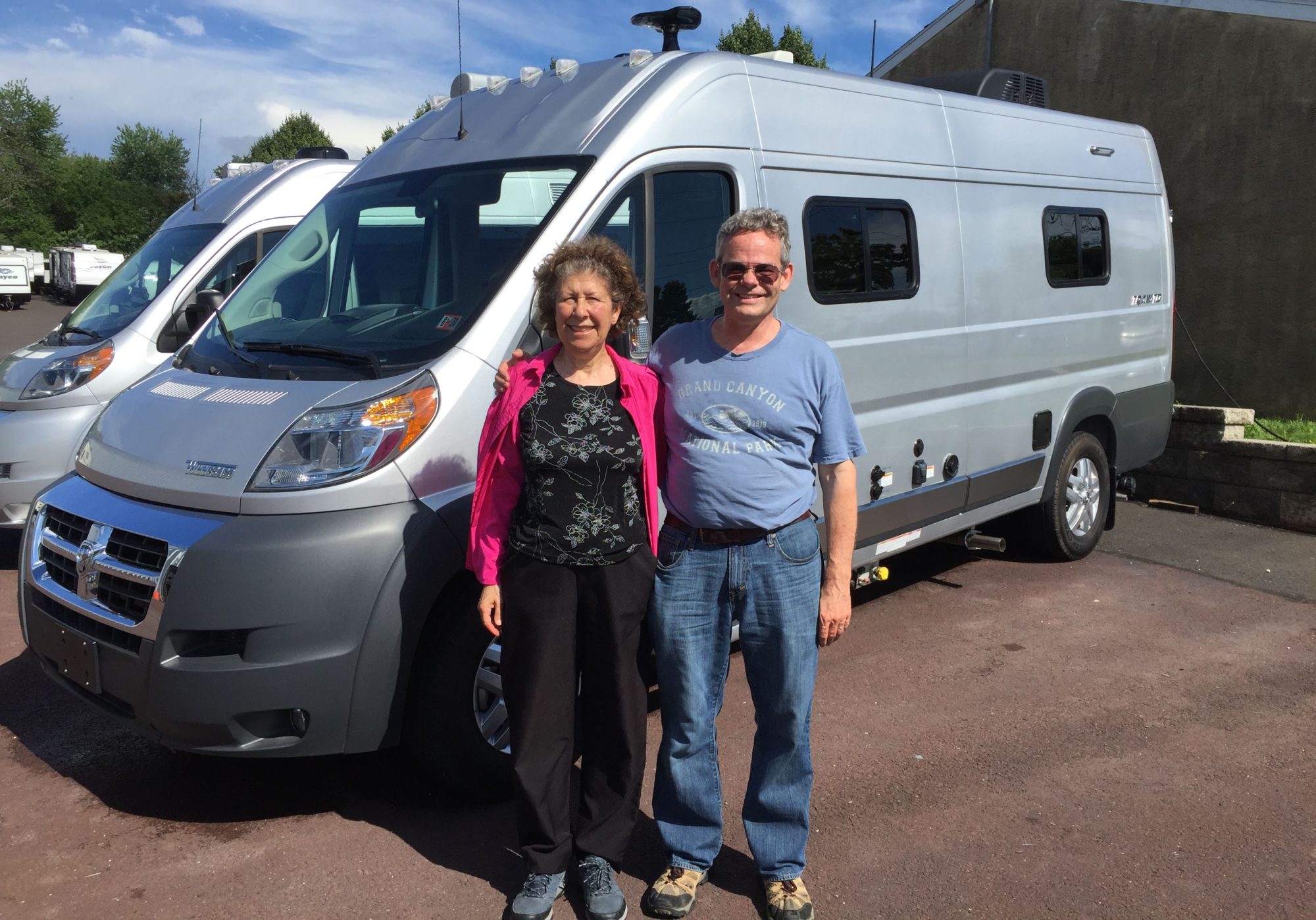
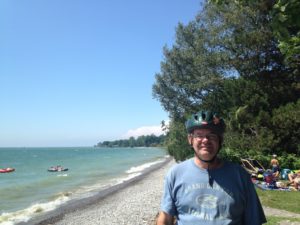 We headed off to Presqu’ile Park, which is on a peninsula jutting into Lake Ontario. It is full of bicycle trails, so we unloaded our bikes on the main loop and biked out to the lighthouse (and lighthouse museum) as well as the main loop. The lighthouse is pretty tall, and it was a bit tough to get a photo with the entire lighthouse in which
We headed off to Presqu’ile Park, which is on a peninsula jutting into Lake Ontario. It is full of bicycle trails, so we unloaded our bikes on the main loop and biked out to the lighthouse (and lighthouse museum) as well as the main loop. The lighthouse is pretty tall, and it was a bit tough to get a photo with the entire lighthouse in which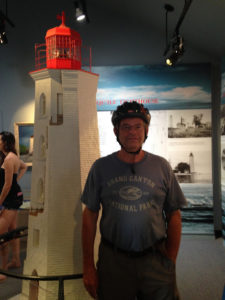 Chuck was big enough to see.
Chuck was big enough to see. 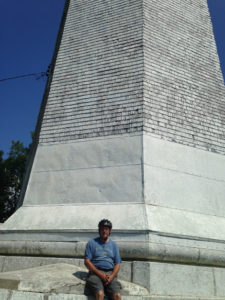 Here he is sitting at its base and beside a model of the lighthouse in the museum. The lighthouse museum is on a spit of land that was apparently known for its warblers – we saw several without much effort, as well as swans and the ubiquitous Canada geese.
Here he is sitting at its base and beside a model of the lighthouse in the museum. The lighthouse museum is on a spit of land that was apparently known for its warblers – we saw several without much effort, as well as swans and the ubiquitous Canada geese.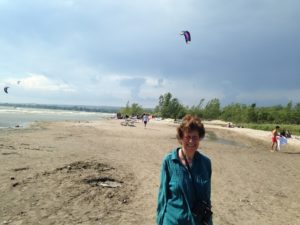 On the other side of the peninsula are fine sand beaches which allow swimming and kiteboarding. We went to have a look, and stayed to watch the kiteboarders. The water there is very shallow and surprisingly warm. (Off Toronto Island, where I occasionally swam as a kid, Lake Ontario is icy.) The wind was strong and steady. Up to 30 kiteboarders were in the water, zipping along at great speed. Some of the kiteboards are on hydrofoils – with enough speed, the surfer and board rise about 2 feet above the water surface, with only the hydrofoil in the water. As well, some people were doing jumps, lifting more than 10 feet into the air before descending to the water surface. It looks like great fun, and quite dangerous. I have no idea how you learn this sport – it seems like it would be a good way to get injured.
On the other side of the peninsula are fine sand beaches which allow swimming and kiteboarding. We went to have a look, and stayed to watch the kiteboarders. The water there is very shallow and surprisingly warm. (Off Toronto Island, where I occasionally swam as a kid, Lake Ontario is icy.) The wind was strong and steady. Up to 30 kiteboarders were in the water, zipping along at great speed. Some of the kiteboards are on hydrofoils – with enough speed, the surfer and board rise about 2 feet above the water surface, with only the hydrofoil in the water. As well, some people were doing jumps, lifting more than 10 feet into the air before descending to the water surface. It looks like great fun, and quite dangerous. I have no idea how you learn this sport – it seems like it would be a good way to get injured.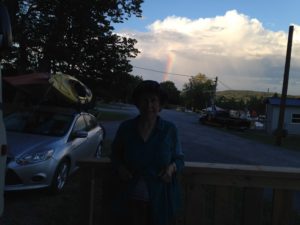 When large dark clouds appeared over the lake, we decided to head back to the campsite. It did not actually rain on us, but we had a rainbow and a very nice sunset. With our site on the hill after dark we had a terrific view of several thunderstorms which lit up the night sky behind the clouds.
When large dark clouds appeared over the lake, we decided to head back to the campsite. It did not actually rain on us, but we had a rainbow and a very nice sunset. With our site on the hill after dark we had a terrific view of several thunderstorms which lit up the night sky behind the clouds.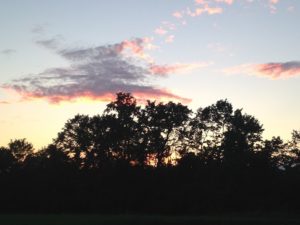
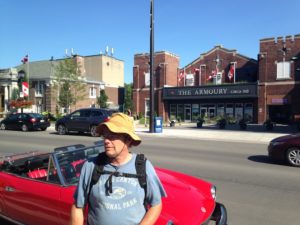 In the afternoon, we headed out for the town of Picton, and Sandbanks Provincial Park. The town was a cute touristy town. The park was really hopping. We did not realize that we could go directly to the parking lot and get a sticker there. Instead, we spent almost half an hour in line, before deciding we would rather not pay the day fee (it was close to 4) and would park outside. (That was a mistake – we had to pay anyways, and I would rather have paid the facility we actually used.)
In the afternoon, we headed out for the town of Picton, and Sandbanks Provincial Park. The town was a cute touristy town. The park was really hopping. We did not realize that we could go directly to the parking lot and get a sticker there. Instead, we spent almost half an hour in line, before deciding we would rather not pay the day fee (it was close to 4) and would park outside. (That was a mistake – we had to pay anyways, and I would rather have paid the facility we actually used.)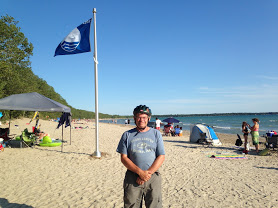 Once parked, we bicycled into the park. It is aptly named, with several very sandy beaches and lots of dunes. We bicycled around and saw most of the beaches. We could see why it is so popular – a great place to bring the kids for swimming and beach activities.
Once parked, we bicycled into the park. It is aptly named, with several very sandy beaches and lots of dunes. We bicycled around and saw most of the beaches. We could see why it is so popular – a great place to bring the kids for swimming and beach activities.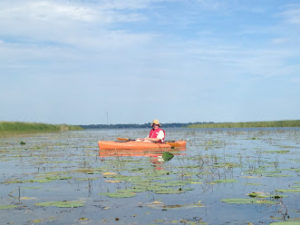 On Sunday, we decided to launch the kayaks into the bay between Presqu’isle Park and Brighton. This is a marshy area, with a lot of birds, particularly swans, and lots of marsh flowers. We had a nice paddle.
On Sunday, we decided to launch the kayaks into the bay between Presqu’isle Park and Brighton. This is a marshy area, with a lot of birds, particularly swans, and lots of marsh flowers. We had a nice paddle.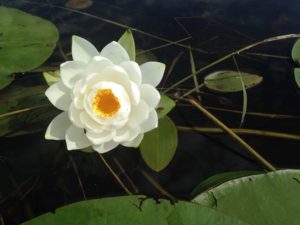 Lake Ontario is no longer as high as it was in May, but many cottages still had sandbags protecting their foundations or gardens. (These are the orange bags piled on the rocks.) I also spent an hour on the bicycle trail that goes along the shore.
Lake Ontario is no longer as high as it was in May, but many cottages still had sandbags protecting their foundations or gardens. (These are the orange bags piled on the rocks.) I also spent an hour on the bicycle trail that goes along the shore.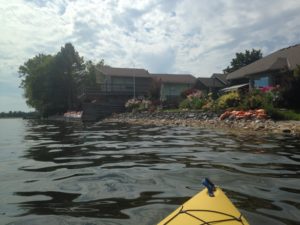
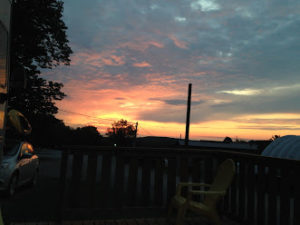 Monday morning we needed to be in Gananoque (Ga-na-nok-kwa) at 8:30 a.m. for our appointment with RV repairs. We got up very early – our reward was a beautiful sunrise. We packed up and headed out in record time.
Monday morning we needed to be in Gananoque (Ga-na-nok-kwa) at 8:30 a.m. for our appointment with RV repairs. We got up very early – our reward was a beautiful sunrise. We packed up and headed out in record time.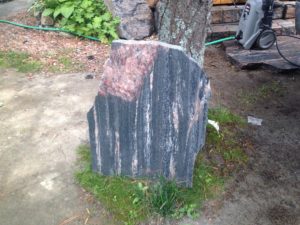 These are some of the oldest pre-Cambrian rocks exposed on the earth’s surface; millenia of erosion have worn them down to their granite cores. Any lake that is big enough has islands where mountains used to stand. Any hill that is big enough has a lake. One of our fellow campers works for a company that quarries and slices the granite for construction and this lovely polished slab outside his camper shows what it can look like when polished and sealed.
These are some of the oldest pre-Cambrian rocks exposed on the earth’s surface; millenia of erosion have worn them down to their granite cores. Any lake that is big enough has islands where mountains used to stand. Any hill that is big enough has a lake. One of our fellow campers works for a company that quarries and slices the granite for construction and this lovely polished slab outside his camper shows what it can look like when polished and sealed.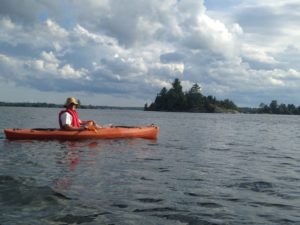 We debated whether to camp near the highway (or usual plan) or near a lake. The lake won out. It was a bit nerve-wracking to wend our way along the small roads to get to Silver Pines, but we do have a lovely view over Sparrow Lake. And we went kayaking before supper visiting several islands.
We debated whether to camp near the highway (or usual plan) or near a lake. The lake won out. It was a bit nerve-wracking to wend our way along the small roads to get to Silver Pines, but we do have a lovely view over Sparrow Lake. And we went kayaking before supper visiting several islands.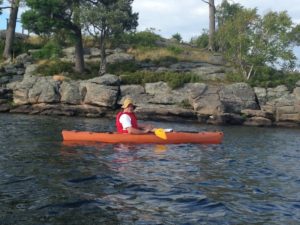 Sparrow Lake is bigger than it looks on the map, however, and there are lots of motor boats.
Sparrow Lake is bigger than it looks on the map, however, and there are lots of motor boats.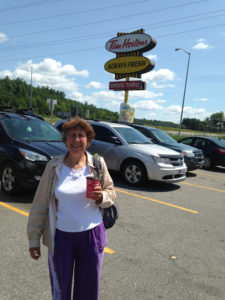 We started by having lunch at Tim Hortons, a Canadian donut store chain which is Canada’s answer to Dunkin’ Donuts. The chain was started in 1964 by hockey star Tim Horton, who died before it really became a huge business. Now there seem to be franchises on every corner in every Canadian town and city. The lunch food was very good, and Chuck enjoyed his dessert donut as well.
We started by having lunch at Tim Hortons, a Canadian donut store chain which is Canada’s answer to Dunkin’ Donuts. The chain was started in 1964 by hockey star Tim Horton, who died before it really became a huge business. Now there seem to be franchises on every corner in every Canadian town and city. The lunch food was very good, and Chuck enjoyed his dessert donut as well.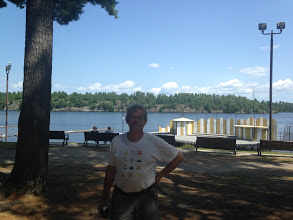 We then headed for the Gull Lake Rotary Park in Gravenhurt to launch the kayaks. The park has a band shell (behind Chuck in the photo) which is actually out in the lake. Gull Lake, which is the lake to the west of the highway, is very pretty, with many granite islands and rocky shores covered in forests.
We then headed for the Gull Lake Rotary Park in Gravenhurt to launch the kayaks. The park has a band shell (behind Chuck in the photo) which is actually out in the lake. Gull Lake, which is the lake to the west of the highway, is very pretty, with many granite islands and rocky shores covered in forests.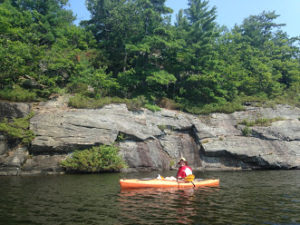 I was reminded of the camp song “Land of the Silver Birch” whose lyrics include “still lake and rocky shore, I shall return once more”. Although I grew up in Toronto, I spent so many summers on lakes like this that it feels like a home-coming to be here.
I was reminded of the camp song “Land of the Silver Birch” whose lyrics include “still lake and rocky shore, I shall return once more”. Although I grew up in Toronto, I spent so many summers on lakes like this that it feels like a home-coming to be here.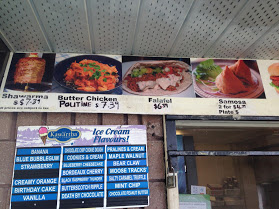 The extent to which Canada has embraced cultural diversity is amazing. Fusion of local cuisine with the cuisine of many countries can be found everywhere. Gravenhurst is a small town, yet the park snack bar food includes (along with the traditional ice cream, hotdogs and hamburgers) shawarmas, falafel, samosas and my personal favorite menu item, butter chicken poutine. (i.e. I like the idea, it was too close to lunch to sample the poutine. Poutine is a French Canadian dish built in French fries, and usually includes at minimum, fries, gravy and melted cheese. Butter chicken is that creamy chicken dish served in north Indian restaurants.) We settled for ice cream, though.
The extent to which Canada has embraced cultural diversity is amazing. Fusion of local cuisine with the cuisine of many countries can be found everywhere. Gravenhurst is a small town, yet the park snack bar food includes (along with the traditional ice cream, hotdogs and hamburgers) shawarmas, falafel, samosas and my personal favorite menu item, butter chicken poutine. (i.e. I like the idea, it was too close to lunch to sample the poutine. Poutine is a French Canadian dish built in French fries, and usually includes at minimum, fries, gravy and melted cheese. Butter chicken is that creamy chicken dish served in north Indian restaurants.) We settled for ice cream, though.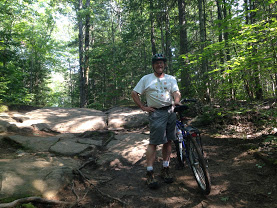 On Tuesday, a glance at Wednesday’s weather forecast (bad) made us reconsider our plan to see the town, in favor of enjoying the good weather while mountain biking at Buckwallow Cycling Center. It came highly recommended on TripAdvisor and other searches. The staff member who met us recommended a number of easy trails. These trails may be easy for mountain bikers, but for us, on our touring bikes, they were pretty challenging. Although the routes were almost flat, there were a lot of tight curves, protruding tree roots, and steep (although very short) ups and downs over the rocky outcrops as above.
On Tuesday, a glance at Wednesday’s weather forecast (bad) made us reconsider our plan to see the town, in favor of enjoying the good weather while mountain biking at Buckwallow Cycling Center. It came highly recommended on TripAdvisor and other searches. The staff member who met us recommended a number of easy trails. These trails may be easy for mountain bikers, but for us, on our touring bikes, they were pretty challenging. Although the routes were almost flat, there were a lot of tight curves, protruding tree roots, and steep (although very short) ups and downs over the rocky outcrops as above. 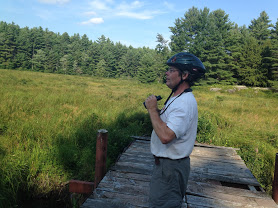 After just over a hour, we were ready to pack it in. However, when we got back to the car, the attendant who had taken over asked us if we had seen any moose at the bottom of the trail. We decided to go back (using the easiest route) to take a look. Just a few feet from the trail there turned out to be a bog that was perfect moose and bird habitat. Alas, our efforts were rewarded only with a view of the vista and a lot of dragonflies. Still, we were happy that we went back.
After just over a hour, we were ready to pack it in. However, when we got back to the car, the attendant who had taken over asked us if we had seen any moose at the bottom of the trail. We decided to go back (using the easiest route) to take a look. Just a few feet from the trail there turned out to be a bog that was perfect moose and bird habitat. Alas, our efforts were rewarded only with a view of the vista and a lot of dragonflies. Still, we were happy that we went back.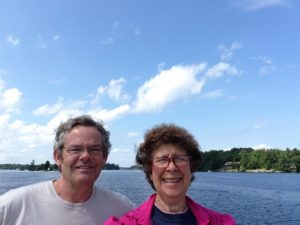
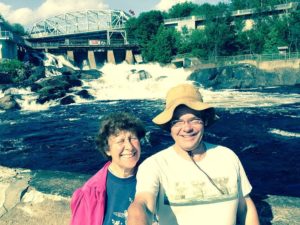 We then went to Bracebridge, the other gateway town for the region to look around. Bracebridge also has a cute downtown, as well as a waterfall. With all the rain we have had recently, the waterfall was really roaring.
We then went to Bracebridge, the other gateway town for the region to look around. Bracebridge also has a cute downtown, as well as a waterfall. With all the rain we have had recently, the waterfall was really roaring.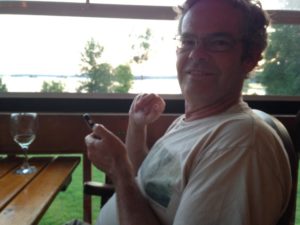 To celebrate our anniversary, we went to the Silver Pines Restaurant, for their specialty – fish and chips. It is deservedly well-known. Our westward facing window seat gave us a great view of the setting sun.
To celebrate our anniversary, we went to the Silver Pines Restaurant, for their specialty – fish and chips. It is deservedly well-known. Our westward facing window seat gave us a great view of the setting sun.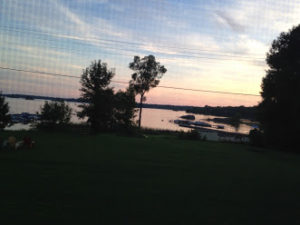
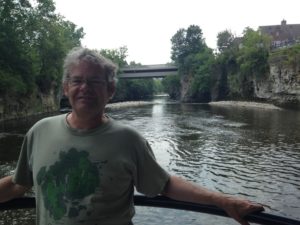 On Thursday, Chuck had a very brief phone meeting for work, after which we headed out to Elora Gorge. The gorge was cut by the Grand River, through a piece of the Niagara Escarpment. We started in the cute town of Fergus, which has built a short but pretty riverwalk along a low piece of the gorge and ended in the town of Elora,
On Thursday, Chuck had a very brief phone meeting for work, after which we headed out to Elora Gorge. The gorge was cut by the Grand River, through a piece of the Niagara Escarpment. We started in the cute town of Fergus, which has built a short but pretty riverwalk along a low piece of the gorge and ended in the town of Elora,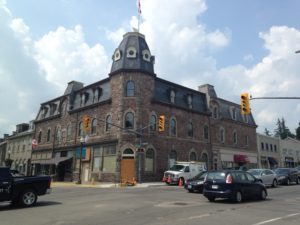 which also straddles the river. Both towns were founded by Scotsmen, and Fergus in particular continues to play up the Scots connection, with Tartan on the bridge, a Scottish goods boutique and a chainsaw carving that resembles the Braveheart statue in Sterling.
which also straddles the river. Both towns were founded by Scotsmen, and Fergus in particular continues to play up the Scots connection, with Tartan on the bridge, a Scottish goods boutique and a chainsaw carving that resembles the Braveheart statue in Sterling.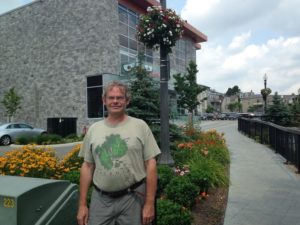
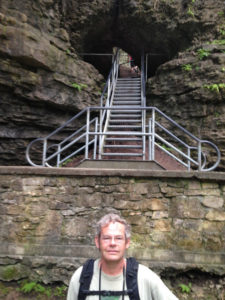 We took a nice hike along the rim of the gorge in Elora Gorge Conservation Area. This is not as spectacular as the gorges in Ithaca, but is a very nice walk through a cedar forest. A popular feature is “Hole in the Rock” which is a pathway through a natural hole in the cliff.
We took a nice hike along the rim of the gorge in Elora Gorge Conservation Area. This is not as spectacular as the gorges in Ithaca, but is a very nice walk through a cedar forest. A popular feature is “Hole in the Rock” which is a pathway through a natural hole in the cliff. 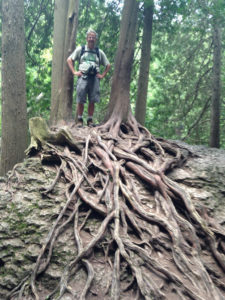 The trees have interesting roots that grip the cracks in the rock. You can take an inner tube through the rapids below. We were tempted, but our visit was cut short by an intense, although relatively brief, thunderstorm. We went into the town of Elora for ice cream instead.
The trees have interesting roots that grip the cracks in the rock. You can take an inner tube through the rapids below. We were tempted, but our visit was cut short by an intense, although relatively brief, thunderstorm. We went into the town of Elora for ice cream instead.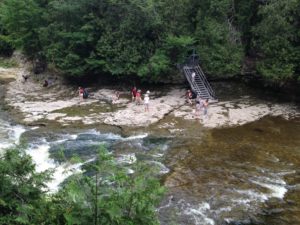
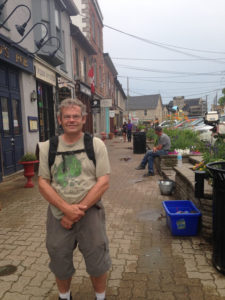
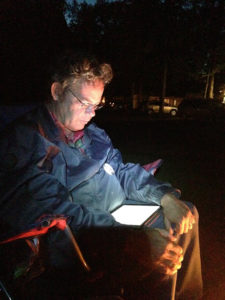 Whether it is the season or the campground, it is very buggy here in the evenings. There are a few mosquitoes, but mostly it is gnats nipping at our ankles. This has impacted our picnic dinners. We are back to eating dinner indoors for the time-being.
Whether it is the season or the campground, it is very buggy here in the evenings. There are a few mosquitoes, but mostly it is gnats nipping at our ankles. This has impacted our picnic dinners. We are back to eating dinner indoors for the time-being.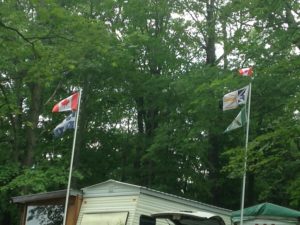
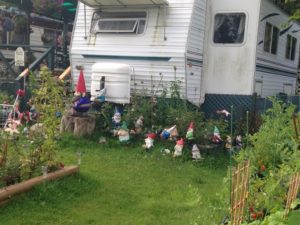 Campgrounds have character. For example, as I mentioned there is a quilting group at Heron Point. At Indian Line, we had the hanging basket folks – most of the seasonal sites have gardens full of flowers. Here we have the garden statuary group! Garden gnomes appear to be particularly popular.
Campgrounds have character. For example, as I mentioned there is a quilting group at Heron Point. At Indian Line, we had the hanging basket folks – most of the seasonal sites have gardens full of flowers. Here we have the garden statuary group! Garden gnomes appear to be particularly popular.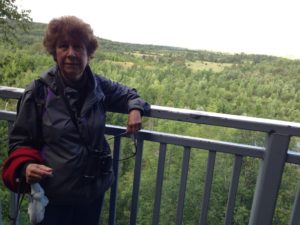 In the afternoon, it was a bit chilly, but things dried out. We took a walk along the Bruce Trail at Mono Cliffs Provincial Park. This lovely trail goes along the escarpment through old growth cedar forest, old apple orchards, secondary deciduous forest, abandoned fields, etc.
In the afternoon, it was a bit chilly, but things dried out. We took a walk along the Bruce Trail at Mono Cliffs Provincial Park. This lovely trail goes along the escarpment through old growth cedar forest, old apple orchards, secondary deciduous forest, abandoned fields, etc.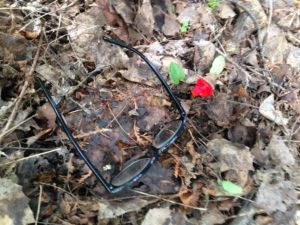 The view is not good – too many trees – but there is a large variety of plant life. Mushrooms were plentiful, including this tiny bright red mushroom and this nerf-ball sized coral mushroom.
The view is not good – too many trees – but there is a large variety of plant life. Mushrooms were plentiful, including this tiny bright red mushroom and this nerf-ball sized coral mushroom.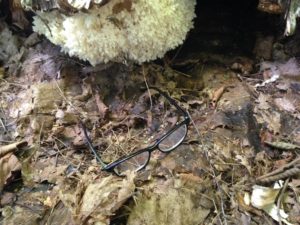
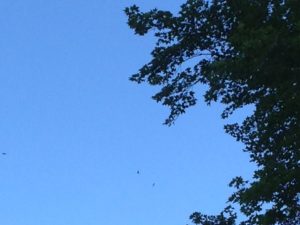 Just before returning to the parking lot, we came across an amazing sight – a monarch butterfly tree, just like the photos you see o the trees in Mexico where they hang out in the winter. In this photo, the 3 specks are monarch butterflies. The tree branch was covered with dozens of butterflies (but this is impossible to capture on a phone camera). We had seen a lot of butterflies during our walk. But we were not expecting this sight, which is something I have never seen north of southern California.
Just before returning to the parking lot, we came across an amazing sight – a monarch butterfly tree, just like the photos you see o the trees in Mexico where they hang out in the winter. In this photo, the 3 specks are monarch butterflies. The tree branch was covered with dozens of butterflies (but this is impossible to capture on a phone camera). We had seen a lot of butterflies during our walk. But we were not expecting this sight, which is something I have never seen north of southern California.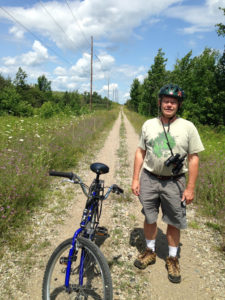 On Sunday the sun came out. We took a short bicycle ride on the CP Rail Trail. This turns out to be primarily an ATV trail and is maintained by the local ATV and snow mobile clubs. The surface was a bit rough for touring bikes, and the straight flat trail is probably too dull for your typical mountain biker. The ride was pleasant enough, through primarily farms and a bit of forest.But if we come back, we will try some of the trails the border one of the little lakes nearby.
On Sunday the sun came out. We took a short bicycle ride on the CP Rail Trail. This turns out to be primarily an ATV trail and is maintained by the local ATV and snow mobile clubs. The surface was a bit rough for touring bikes, and the straight flat trail is probably too dull for your typical mountain biker. The ride was pleasant enough, through primarily farms and a bit of forest.But if we come back, we will try some of the trails the border one of the little lakes nearby.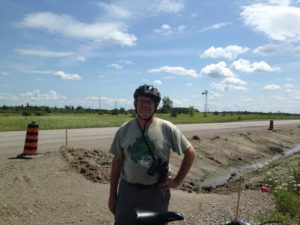
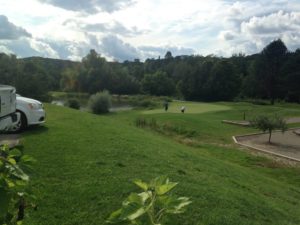 The wedding was in the evening in the Hockley Resort, which is in lovely Hockley Valley. The escarpment forms a sort of bowl here, so that you are surrounded by the forested hills. With the blue sky and perfect temperatures, it was a perfect setting.
The wedding was in the evening in the Hockley Resort, which is in lovely Hockley Valley. The escarpment forms a sort of bowl here, so that you are surrounded by the forested hills. With the blue sky and perfect temperatures, it was a perfect setting.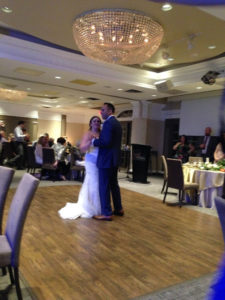 Dan, the son of our friends Kathy and Salomon, and Caleigh got married in the garden. The service was beautifully done – a merger of Jewish and Christian, modern and traditional, with a lot of personalization. One element we particularly liked was that the JP had asked each of them to write a short piece about what they loved about their new spouse. This was really beautiful and something I think every married couple should do frequently, in keeping with my philosophy that we should focus on what we are thankful for. (We might even try it.)
Dan, the son of our friends Kathy and Salomon, and Caleigh got married in the garden. The service was beautifully done – a merger of Jewish and Christian, modern and traditional, with a lot of personalization. One element we particularly liked was that the JP had asked each of them to write a short piece about what they loved about their new spouse. This was really beautiful and something I think every married couple should do frequently, in keeping with my philosophy that we should focus on what we are thankful for. (We might even try it.)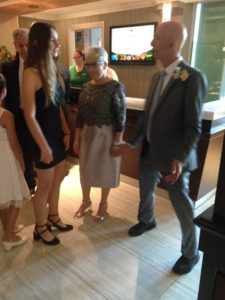 Kathy and Salo (the folks on the right in the photo) and I were graduate students in Statistics together at U. of Toronto in 1978 (although I actually became friends with Kathy years earlier when the University of Toronto offered enrichment lectures to high school math students). I got quite a shock at the wedding to be greeted by another classmate, Jose, and his wife Lucia, whom I had not seen since I left the program in 1979. Once Jose graduated, they returned to their native Mexico, where Jose took up a number of important positions. Salo has family in Mexico and so he and Kathy visit there relatively frequently and have kept in touch.
Kathy and Salo (the folks on the right in the photo) and I were graduate students in Statistics together at U. of Toronto in 1978 (although I actually became friends with Kathy years earlier when the University of Toronto offered enrichment lectures to high school math students). I got quite a shock at the wedding to be greeted by another classmate, Jose, and his wife Lucia, whom I had not seen since I left the program in 1979. Once Jose graduated, they returned to their native Mexico, where Jose took up a number of important positions. Salo has family in Mexico and so he and Kathy visit there relatively frequently and have kept in touch.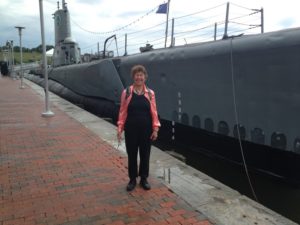 By 4:00 I was checked into my hotel. With nothing to do until 6 or so, and with the weather clearing, I took a walk around the inner harbor, which is quite nice. There is a ship museum, which allows you to visit several ships, like this submarine, of various eras. I had planned to visit the Baltimore aquarium, but it was very crowded, with a wait until 6:15 for entry.
By 4:00 I was checked into my hotel. With nothing to do until 6 or so, and with the weather clearing, I took a walk around the inner harbor, which is quite nice. There is a ship museum, which allows you to visit several ships, like this submarine, of various eras. I had planned to visit the Baltimore aquarium, but it was very crowded, with a wait until 6:15 for entry.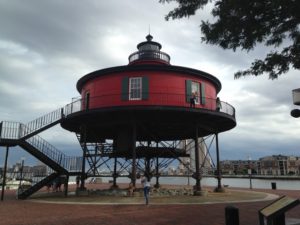 Instead, I walked along the harbor, toured this historic lighthouse, and walked through the Italian district. I also dropped off a prescription.
Instead, I walked along the harbor, toured this historic lighthouse, and walked through the Italian district. I also dropped off a prescription.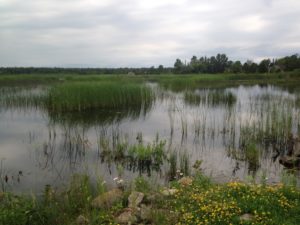 We decided to try a campground on Heron Point near Lion’s Head but on Lake Huron, rather than on Georgian Bay.
We decided to try a campground on Heron Point near Lion’s Head but on Lake Huron, rather than on Georgian Bay.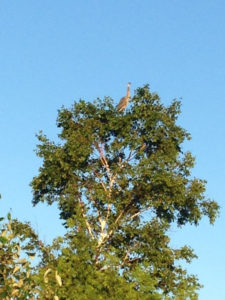 After winding along
After winding along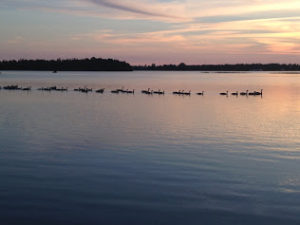 We might be camping, but Game of Thrones still reigns in our household! Thanks to Chuck’s foresight in setting up our viewing options, we were able to view episode 2 with the rest of the world while watching the sun set through our RV window.
We might be camping, but Game of Thrones still reigns in our household! Thanks to Chuck’s foresight in setting up our viewing options, we were able to view episode 2 with the rest of the world while watching the sun set through our RV window.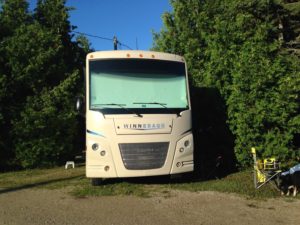 With the bad weather (temperatures in the mid 50’s, wind, rain), I thought there was a chance of a cancellation which would enable us to stay in the campground. But campers are a hardy lot – even the tenters continued to come in. However, we had some very nice chats with our hosts about the wonderful time we had in their hometown of Owen Sound, and in the end they moved some equipment that was blocking a small but usable campsite, and let us stay there until the end of our visit. To get the great view, we just need to walk a few yards to the picnic pavilion.
With the bad weather (temperatures in the mid 50’s, wind, rain), I thought there was a chance of a cancellation which would enable us to stay in the campground. But campers are a hardy lot – even the tenters continued to come in. However, we had some very nice chats with our hosts about the wonderful time we had in their hometown of Owen Sound, and in the end they moved some equipment that was blocking a small but usable campsite, and let us stay there until the end of our visit. To get the great view, we just need to walk a few yards to the picnic pavilion.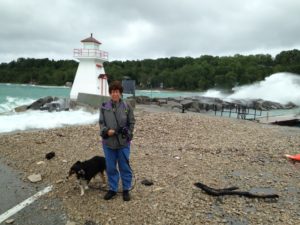 We decided to take a trip to Lion’s Head on the other side of the peninsula in the hope of getting away from the wind and the rain. Lion’s Head also lies on a small bay. It was amazing – the winds were much, much stronger.
We decided to take a trip to Lion’s Head on the other side of the peninsula in the hope of getting away from the wind and the rain. Lion’s Head also lies on a small bay. It was amazing – the winds were much, much stronger.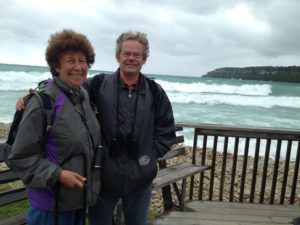 As a result, the waves in the bay were huge. The bay itself is ringed by the high cliffs of the Niagara Escarpment. After watching the waves on hit the breakwater and lighthouse, we took a brief walk on the Bruce Trail to view the lake and cliffs.
As a result, the waves in the bay were huge. The bay itself is ringed by the high cliffs of the Niagara Escarpment. After watching the waves on hit the breakwater and lighthouse, we took a brief walk on the Bruce Trail to view the lake and cliffs.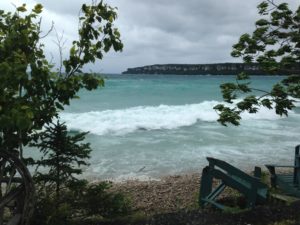 The Bruce Trail (http://brucetrail.org/) is a hiking trail from Tobermory, at the tip of the Bruce Peninsula, to Niagara, a distance of some 600 miles. There are also about 300 miles of side-trails, such as the one we took in Owen Sound to reach Inglis Falls. The trail covers both public and private ground – establishing it needed some political goodwill – but the route has been continuous since about 1965. On the Bruce Peninsula, the trail provides some spectacular views. For the particular portion of the trail through Lion’s Head, the best views were on private parts of the trail and I am grateful to the owners who allowed right-of-way.
The Bruce Trail (http://brucetrail.org/) is a hiking trail from Tobermory, at the tip of the Bruce Peninsula, to Niagara, a distance of some 600 miles. There are also about 300 miles of side-trails, such as the one we took in Owen Sound to reach Inglis Falls. The trail covers both public and private ground – establishing it needed some political goodwill – but the route has been continuous since about 1965. On the Bruce Peninsula, the trail provides some spectacular views. For the particular portion of the trail through Lion’s Head, the best views were on private parts of the trail and I am grateful to the owners who allowed right-of-way.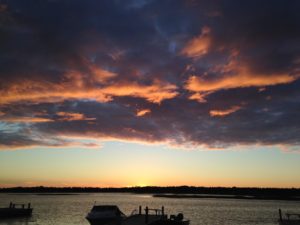 We had a beautiful sunset over the bay, as the clouds began to break. As darkness fell, electricity was restored and the lights went on in the cabins and RVs. Despite that, the campground is quite dark.
We had a beautiful sunset over the bay, as the clouds began to break. As darkness fell, electricity was restored and the lights went on in the cabins and RVs. Despite that, the campground is quite dark.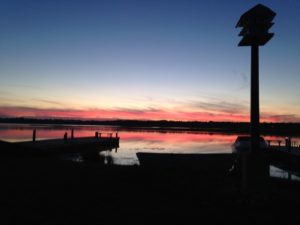 The day ended with a beautiful sunset.
The day ended with a beautiful sunset.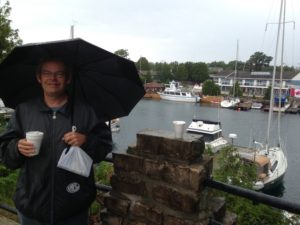 We decided to go to Tobermory. It had been raining off and on all morning, but of course when we got to Tobermory the rain began in earnest. We decided to see the town, which is small and very touristy.
We decided to go to Tobermory. It had been raining off and on all morning, but of course when we got to Tobermory the rain began in earnest. We decided to see the town, which is small and very touristy.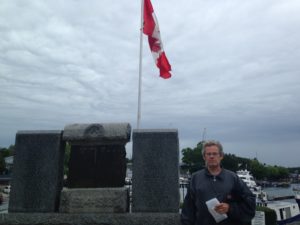 It has two small harbors – one which houses the large car ferry which goes to Manitoulin Island and the other which houses all the other boats and which is bordered by tourist shops and restaurants.
It has two small harbors – one which houses the large car ferry which goes to Manitoulin Island and the other which houses all the other boats and which is bordered by tourist shops and restaurants.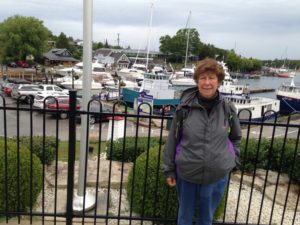
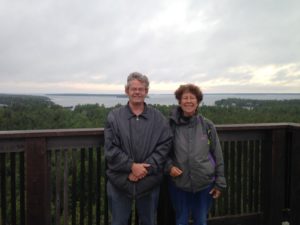 The Visitor Center has a very nice museum. I picked up Chuck from town and we went back to the lookout tower and to the museum together. The museum explains the natural history of the peninsula, as well as the establishment of Fathom Five National Underwater Preserve, which includes 21 (or is it 26?) shipwrecks. Due to the introduction of invasive zebra and quagga mussels, which are efficient filter feeders, there is little plankton in the water and the wrecks can be clearly viewed from glass-bottom boats or scuba diving. Interestingly enough, only 2 sailors died in all these wrecks, but several divers have died exploring the remains. We also climbed back up the tower for a look over the lake.
The Visitor Center has a very nice museum. I picked up Chuck from town and we went back to the lookout tower and to the museum together. The museum explains the natural history of the peninsula, as well as the establishment of Fathom Five National Underwater Preserve, which includes 21 (or is it 26?) shipwrecks. Due to the introduction of invasive zebra and quagga mussels, which are efficient filter feeders, there is little plankton in the water and the wrecks can be clearly viewed from glass-bottom boats or scuba diving. Interestingly enough, only 2 sailors died in all these wrecks, but several divers have died exploring the remains. We also climbed back up the tower for a look over the lake.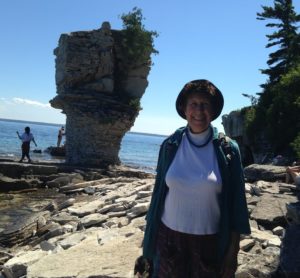
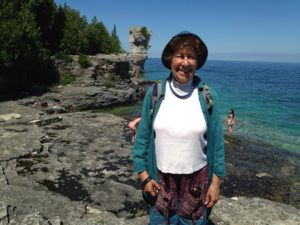
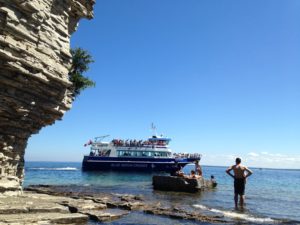
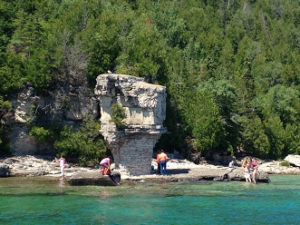
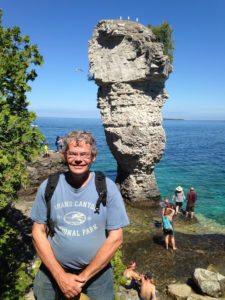
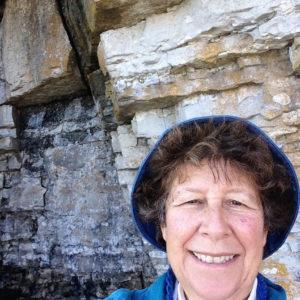
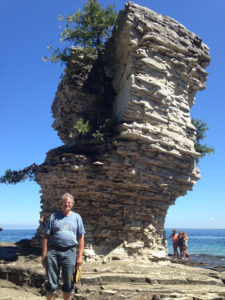
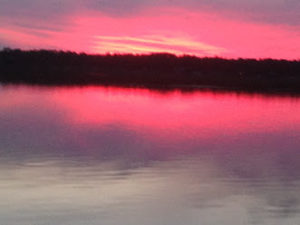 Our visit to the Bruce Peninsula ended with yet another beautiful sunset over Stokes Bay, with a flock of geese tranquilly paddling by and herons flying through. This picture was NOT photoshopped.
Our visit to the Bruce Peninsula ended with yet another beautiful sunset over Stokes Bay, with a flock of geese tranquilly paddling by and herons flying through. This picture was NOT photoshopped. In my childhood, we used to make fun of the way that Americans put flags everywhere. No more. Perhaps it was due to the 150 year anniversary of Canada, but there were flags everywhere – on fence posts, front doors, pick-up trucks, and most notably, taking the place of the traditional hanging baskets of flowers on the main street lampposts of most of the small towns we passed through. A single small town yielded more Canadian flags than I used to see in a year – and that includes 1967, Canada’s centennial and the year that the maple leaf flag was adopted.
In my childhood, we used to make fun of the way that Americans put flags everywhere. No more. Perhaps it was due to the 150 year anniversary of Canada, but there were flags everywhere – on fence posts, front doors, pick-up trucks, and most notably, taking the place of the traditional hanging baskets of flowers on the main street lampposts of most of the small towns we passed through. A single small town yielded more Canadian flags than I used to see in a year – and that includes 1967, Canada’s centennial and the year that the maple leaf flag was adopted. Owen Sound has a lovely civic park, Harrison Park, that has RV sites. We pulled in beside the Sydenham River, and near Weaver Creek, both of which flow through the park.
Owen Sound has a lovely civic park, Harrison Park, that has RV sites. We pulled in beside the Sydenham River, and near Weaver Creek, both of which flow through the park.  Among its many amenities, the park has a nice restaurant (which we visited for supper), a small bird sanctuary, a historical park celebrating Owen Sound’s historical significance as a final destination on the Underground Railroad, links to the Bruce Trail (which runs 890 km from Tobermory to Niagara Falls along the Niagara Escarpment, with 400 km of side trails) and a swimming pool.
Among its many amenities, the park has a nice restaurant (which we visited for supper), a small bird sanctuary, a historical park celebrating Owen Sound’s historical significance as a final destination on the Underground Railroad, links to the Bruce Trail (which runs 890 km from Tobermory to Niagara Falls along the Niagara Escarpment, with 400 km of side trails) and a swimming pool.
 We thought it was obvious that we were in a forest and were surprised that certification would be needed to verify the fact. Actually the certification is for the management program for the forested lands.
We thought it was obvious that we were in a forest and were surprised that certification would be needed to verify the fact. Actually the certification is for the management program for the forested lands.
 On Thursday, after a torrential thunderstorm, we met Stephen in town for coffee and then went back to Harrison Park to hike. We took a branch path of the Bruce Trail to Inglis Falls, which was spectacular after the rain. It was a lovely walk through the woods and through Inglis Arboreteum – although a bit buggy in the damp weather.
On Thursday, after a torrential thunderstorm, we met Stephen in town for coffee and then went back to Harrison Park to hike. We took a branch path of the Bruce Trail to Inglis Falls, which was spectacular after the rain. It was a lovely walk through the woods and through Inglis Arboreteum – although a bit buggy in the damp weather.
 In the morning, Stephen showed up by bicycle for a quick visit. After he left, we considered whether to launch the kayaks.
In the morning, Stephen showed up by bicycle for a quick visit. After he left, we considered whether to launch the kayaks. With our campsite right beside the Sydenham River, it was hard to resist trying out our (fortunately indestructible) kayaks on the small rapids that run the length of the campground. In fact, a lot of kids were going down on inner tubes or inflatable rafts. We both bounced off several boulders, as the water was quite shallow and very fast. However, these kayaks really are indestructible and no harm was down.
With our campsite right beside the Sydenham River, it was hard to resist trying out our (fortunately indestructible) kayaks on the small rapids that run the length of the campground. In fact, a lot of kids were going down on inner tubes or inflatable rafts. We both bounced off several boulders, as the water was quite shallow and very fast. However, these kayaks really are indestructible and no harm was down. In the evening, the park had a First Nations event, featuring a drumming group and a film documentary about the first First Nations’ spelling bee team from Alberta. I cannot imagine the culture shock of the 3 children who won and participated in the national bee in Toronto. One of them made it into the final round – quite an amazing showing.
In the evening, the park had a First Nations event, featuring a drumming group and a film documentary about the first First Nations’ spelling bee team from Alberta. I cannot imagine the culture shock of the 3 children who won and participated in the national bee in Toronto. One of them made it into the final round – quite an amazing showing. This is a history museum documenting primarily post-native settlement in the county, including a “village” made of up reconstructed buildings from the area – a small settler log cabin, a larger log cabin, a 1920’s house, and several other buildings including a barn, sawmill, garage (with old cars and trucks) and blacksmith shop. This iron stove was made in Brantford, the town where I was born.
This is a history museum documenting primarily post-native settlement in the county, including a “village” made of up reconstructed buildings from the area – a small settler log cabin, a larger log cabin, a 1920’s house, and several other buildings including a barn, sawmill, garage (with old cars and trucks) and blacksmith shop. This iron stove was made in Brantford, the town where I was born. He was very knowledgeable about the older vehicles on display, and had worked on some of the newer ones. Many of the buildings had knowledgeable docents suitably dressed in period clothing, but it was special to learn from someone who had actually experienced at least some of the life he was explaining.
He was very knowledgeable about the older vehicles on display, and had worked on some of the newer ones. Many of the buildings had knowledgeable docents suitably dressed in period clothing, but it was special to learn from someone who had actually experienced at least some of the life he was explaining. Our last day in Owen Sound, a red squirrel found our bird feeder. For some reason, only one bird, a blue jay, visited our feeding during our entire stay. Normally, having a squirrel raid the feeder would not thrill me. However, under the circumstances, watching this cute little guy enjoying breakfast at our expense was a real pleasure.
Our last day in Owen Sound, a red squirrel found our bird feeder. For some reason, only one bird, a blue jay, visited our feeding during our entire stay. Normally, having a squirrel raid the feeder would not thrill me. However, under the circumstances, watching this cute little guy enjoying breakfast at our expense was a real pleasure. This little gem is in the old train station on Owen Sound (the bay) across the sound from the big grain elevator. It has a riverwalk with interpretive signs, and a small exhibit space in the station.
This little gem is in the old train station on Owen Sound (the bay) across the sound from the big grain elevator. It has a riverwalk with interpretive signs, and a small exhibit space in the station.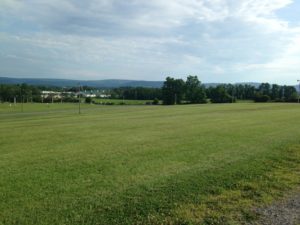 Monday morning most of the bluegrass folks left, and the fairgrounds were much quieter. With so few people around, Rumple could have his walks off-leash, which he loved. The people who work on the grounds all seem to love dogs, and so our occasional encounters with staff were friendly.
Monday morning most of the bluegrass folks left, and the fairgrounds were much quieter. With so few people around, Rumple could have his walks off-leash, which he loved. The people who work on the grounds all seem to love dogs, and so our occasional encounters with staff were friendly.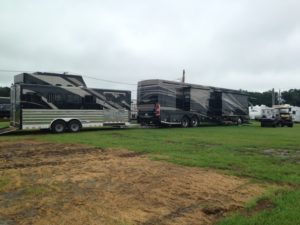 We were intrigued by the horse trailers and RVs. I am sure that some participants stayed in hotels. However, there seemed to be two themes for RVs – large RVs pulling large horse trailers, and even larger RVs that are separated into living quarters for humans and quarters for horses.
We were intrigued by the horse trailers and RVs. I am sure that some participants stayed in hotels. However, there seemed to be two themes for RVs – large RVs pulling large horse trailers, and even larger RVs that are separated into living quarters for humans and quarters for horses. 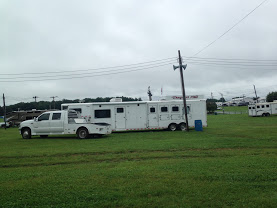 Since the horses moved into the horse stalls upon arrival (and I think some of the many dogs moved in with the horses) there was plenty of room for the people.
Since the horses moved into the horse stalls upon arrival (and I think some of the many dogs moved in with the horses) there was plenty of room for the people.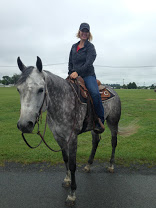 Since we were not involved, and did not know whether we needed tickets to watch, we just observed from afar, although I did take a few pictures of people exercising their horses.
Since we were not involved, and did not know whether we needed tickets to watch, we just observed from afar, although I did take a few pictures of people exercising their horses. 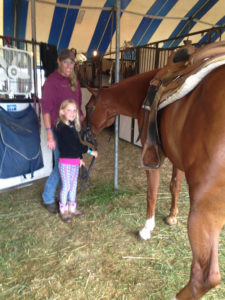 Although my own kids took riding lessons one summer, I was still amazed at watching young children work with these large horses.
Although my own kids took riding lessons one summer, I was still amazed at watching young children work with these large horses.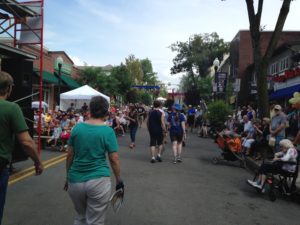
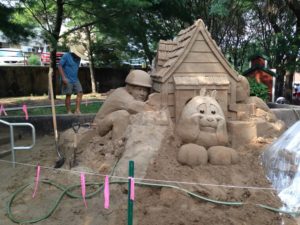 Wednesday was a work day. I had a student meeting and Chuck went to work with Phil. As I was finished early, I visited the Children’s Craft Fair, which is always held on the first day of Arts Fest. I really only did a quick walk-through, however, as I biked off to meet Chuck at the music store.
Wednesday was a work day. I had a student meeting and Chuck went to work with Phil. As I was finished early, I visited the Children’s Craft Fair, which is always held on the first day of Arts Fest. I really only did a quick walk-through, however, as I biked off to meet Chuck at the music store.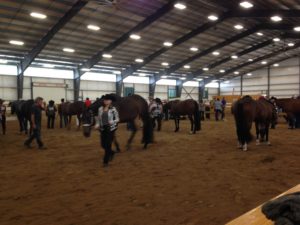 We decided that it was silly to be camped at a horse show without going to see the horses, so we went over to have a look at what was going on at the show rings and barns. Primarily what we saw were obedience trials for the horses, either on lead or being ridden.
We decided that it was silly to be camped at a horse show without going to see the horses, so we went over to have a look at what was going on at the show rings and barns. Primarily what we saw were obedience trials for the horses, either on lead or being ridden. 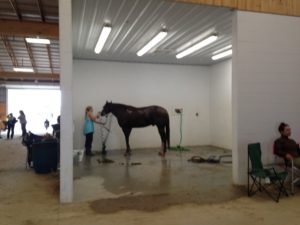 While I am sure that hours of training are involved, these are not too exciting for the audience (at least for people like us) as each competition involves each horse and trainer going through the same routine of trotting, stopping, side-stepping, etc. At the events we saw, most of the participants were women, although the events seemed to be mixed gender.
While I am sure that hours of training are involved, these are not too exciting for the audience (at least for people like us) as each competition involves each horse and trainer going through the same routine of trotting, stopping, side-stepping, etc. At the events we saw, most of the participants were women, although the events seemed to be mixed gender.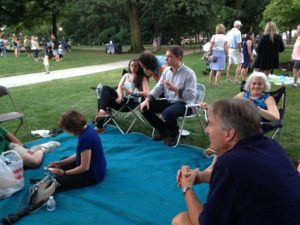 After we watched for a couple of hours, we headed off to downtown State College to join our friends Susie and Phil for Arts Fest. They always stake out a spot near the stage on campus to meet with friends and family.
After we watched for a couple of hours, we headed off to downtown State College to join our friends Susie and Phil for Arts Fest. They always stake out a spot near the stage on campus to meet with friends and family.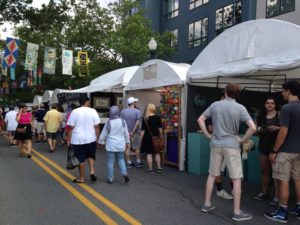 I meandered off to see the arts and crafts, and grabbed a bag of candied almonds en route. The arts and crafts were terrific as always. So were the nuts, except that one of them grabbed a filling which fell out.
I meandered off to see the arts and crafts, and grabbed a bag of candied almonds en route. The arts and crafts were terrific as always. So were the nuts, except that one of them grabbed a filling which fell out.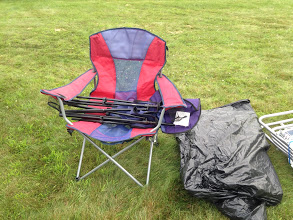 When we entered the fairgrounds, we were told to arrive at the tents with lawn chairs at 1:00 to get a spot. However, on my early morning dogwalk, I discovered that there were signs instructing people to leave their chairs “in line” and return at 1:00 to set up. Here are our chairs in the line. Because of this, we got a very good spot in the second row of a tent. (With rain threatening, the first row did not seem like a great idea!)
When we entered the fairgrounds, we were told to arrive at the tents with lawn chairs at 1:00 to get a spot. However, on my early morning dogwalk, I discovered that there were signs instructing people to leave their chairs “in line” and return at 1:00 to set up. Here are our chairs in the line. Because of this, we got a very good spot in the second row of a tent. (With rain threatening, the first row did not seem like a great idea!)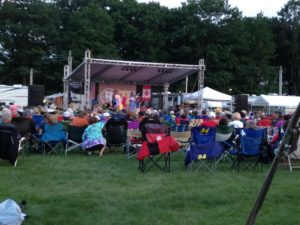 The music started at 2:00 with the national anthem … of Canada. There was in fact, quite a large Canadian contingent (none of whom were flying Confederate flags as far as I saw). The US anthem was next.
The music started at 2:00 with the national anthem … of Canada. There was in fact, quite a large Canadian contingent (none of whom were flying Confederate flags as far as I saw). The US anthem was next.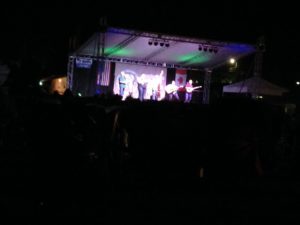 And then the music began! Most days it went continuously from 10 a.m. to 11 p.m. Ryan kept encouraging people to spend some time jamming or go to workshops, but with continuous bands it was hard to find a break to do something besides listen.
And then the music began! Most days it went continuously from 10 a.m. to 11 p.m. Ryan kept encouraging people to spend some time jamming or go to workshops, but with continuous bands it was hard to find a break to do something besides listen.